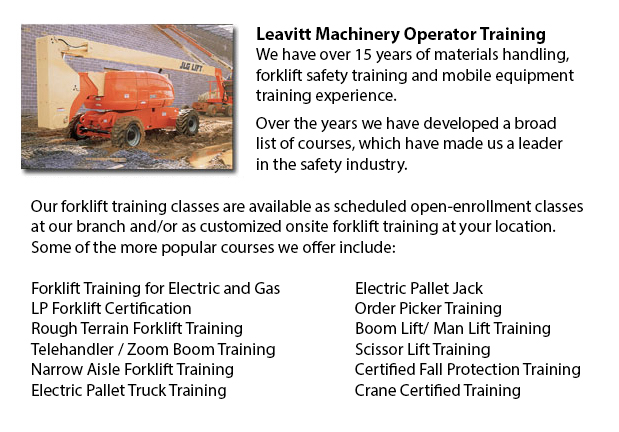
Ottawa Aerial Lift Safety Training - There are about 26 to 30 construction deaths within North America due to the use of aerial lifts. Nearly all of the individuals killed are craftsmen like electrical workers, laborers, painters, ironworkers or carpenters. Nearly all fatalities are caused by electrocutions, falls and tip-overs. The greatest danger is from boom-supported lifts, such as cherry pickers and bucket trucks. Most fatalities are connected to this type of lift, with the rest involving scissor lifts. Other risks include being thrown out of a bucket, being struck by falling things, and being caught between the lift bucket or guardrail and an object, such as a joist or steel beam.
To safely operate an aerial lift, perform a check on the following things before making use of the device: emergency and operating controls, safety devices (like for example, guardrails and outriggers), personal fall protection gear, and wheels and tires. Look for possible leaks in the air, fuel-system, hydraulic fluid. Check the device for loose or missing components.
The location where the device would be utilized should be carefully examined for possible dangers, such as holes, bumps, debris and drop-offs. Overhead power lines must be closely monitored or avoided. It is suggested that aerial lift devices be utilized on level, stable surfaces. Never work on steep slopes which exceed slope limitations which the manufacturer specified. Even on a slope that is level, outriggers, brakes and wheel chocks should be set.
Employers are needed to provide aerial lift operators and maintenance mechanics with the right manuals. Mechanics and operators must be trained by a licensed person experienced with the applicable aerial lift model.
Aerial Lift Safety Guidelines:
o Before operating, close doors and lift platform chains.
o Do not climb on or lean over guardrails. Stand on the floor of the bucket or platform.
o Stay within manufacturer's load-capacity limits.
o Use work-zone warnings, such as cones and signs, when working near traffic.
Electrocutions are avoidable if safety procedures are followed. Stay well away from power lines - at least 10 feet. Qualified electrical workers must insulate and/or de-energize power lines. People working should utilize personal protective equipment and tools, like a bucket which is insulated. Nevertheless, an insulated bucket does not protect from electrocution if, for example, the worker touches a different wire providing a path to the ground.
When in the bucket, workers should prevent possible falls by securing themselves to the guardrails by making use of a positioning device or a full-body harness. If there is an anchorage within the bucket, a positioning belt together with a short lanyard is acceptable.
By following the manufacturer's directions, tip-overs can be prevented. Never drive the lift platform whilst it is elevated, unless otherwise specified by the manufacturer. Follow the vertical and horizontal reach limits of the device, and never exceed the specified load-capacity.
-
Ottawa Boom Lift Ticket
Ottawa Boom Lift Ticket - Boom Lifts are a table lift piece of equipment which could be lifted or lowered to varying heights, making this apparatus a useful tool for many manufacturing purposes. There are some unique types of Boom Lift consisting of... More -
Ottawa Boom Lift Operator Training
Ottawa Boom Lift Operator Training - The cherry picker work platform is a kind of work platform, which will typically have a bucket or platform at the hydraulic lifting system's end. The device is also referred to as a man lift, boom lift, basket cra... More -
Aerial Lift / Boom Lift / Man Lift / Scissor Lift Training in Ottawa
Scissor lifts are forklift tables which raise objects and people and supplies vertically. They are normally utilized in industrial, construction and commercial environments. A common use of scissor lifts is for lifting or lowering construction suppli... More -
Ottawa Crane Certification
Ottawa Crane Certification - The Crane Certification training program covers content suggested by industry concerning the safe and efficient operation of cranes. Individuals training would know the following: pre-operational, operational and post ope... More -
Ottawa Heavy Equipment Training Courses
Ottawa Heavy Equipment Training Courses - The first step required to take when selecting heavy equipment operator courses is determining the capacity you wish to work with heavy machinery. Like for example, you can take courses that will teach you ho... More -
Ottawa Fall Protection Ticket
Ottawa Fall Protection Ticket - Fall-related accidents are the number one reason of death in the construction trade. The potential for fall accidents very much increases based on the kind of work which is being completed within your workplace. So, be... More -
Ottawa Telehandler Operator Training
Ottawa Telehandler Operator Training - Telescopic handler Forklifts or telehandler forklifts are common industrial machinery seen in various construction business settings. The telehandler is a useful machine and makes for a valuable tool that can be... More -
Fall Protection Training in Ottawa
Regrettably, there is a large number of workplace injuries linked to falling and lots of fall-related deaths reported each year. Lots of these instances might have been prevented by having proper measures in place, offering proper training and equipp... More

Forklift Certification Ottawa
TOLL FREE: 1-888-254-6157
Ottawa, Ontario
forkliftcertificationottawa.com
Email Us
About Us


